Sommaire
2025: 10 Grand Seiko “Grammar of Design” Still Under €5,000 (Before They Skyrocket)
Grand Seiko, Seiko’s prestigious division, has forged a unique aesthetic identity since the 1960s, codified by Taro Tanaka’s famous “Grammar of Design.” Today, in 2025, as speculation rages in the watch market, there are still some Grand Seiko references emblematic of this style – and surprisingly affordable, below the €5,000 mark – whose prices could soon soar. Who are these guardians of the Japanese stylistic temple? Why do they embody the Grand Seiko DNA? And above all, do they deserve the attention of a discerning collector before it’s too late (and their prices explode)? Answers from a passionate expert, through a meticulous selection of ten “Grammar of Design” models with strong potential.
The “Grammar of Design”: Nine Commandments of Grand Seiko Style
In 1962, a young Seiko designer named Taro Tanaka laid the foundations for the “Grammar of Design,” literally a design grammar 이론 intended to define Grand Seiko’s visual identity. Until then, the first GS models (appearing in 1960) were technically impressive but remained aesthetically sober, without a strong signature. Tanaka, observing Swiss watches in the shop windows of the Ginza district, understood that Grand Seiko needed to capture the eye with superior brilliance and sharpness. He then formulated three fundamental principles:
- First, all surfaces and angles of the case, dial, hands, and indexes must be flat and geometrically perfect (no complex curvature), to reflect light like a mirror.
- Next, the surfaces must be as wide and faceted as possible, maximizing flat areas on the case and the readability of the hands and indexes.
- Finally, every polished surface must be mirror-finished and distortion-free, for a striking play of light and shadow, achieved through ultra-precise Zaratsu polishing.
Based on these broad principles, Tanaka derived nine concrete elements known as the “Grand Seiko Style.” They can be summarized as follows:
- Double-width index at 12 o’clock (for immediate dial orientation).
- Rectangular, multi-faceted, shiny, and applied hour markers.
- Multi-faceted hour and minute hands with an impeccable sharp edge (often dauphine type).
- Perfectly flat dial (avoiding any curvature that would hinder reading).
- Ultra-mirrored bezel, Zaratsu polished, with sharp, distortion-free edges.
- Case with equally mirror-polished flanks, sharp edges, and deep reflections.
- Case with inwardly curved flanks, to visually slim the watch and play on reflections.
- Semi-recessed crown in the case, providing wrist comfort and a clean side profile.
- Finally, each reference has a specific and original case (no generic case recycled from one model to another). This last point, often overlooked, ensured the uniqueness of each GS: a true industrial feat.
This Grand Seiko style, inaugurated by the 44GS in 1967, is immediately recognizable and will transcend decades, from vintage to contemporary models. It expresses a Japanese philosophy of aesthetics: the beauty born from the contrast between shadow and light on pure surfaces. A Grand Seiko watch must “sparkle with quality,” reflecting the slightest ray of light on its polished facets like a Japanese screen plays with the sun. Tanaka understood: by combining Japanese tradition and industrial rigor, he defined what would become Grand Seiko’s visual DNA to this day, with a timelessness that commands respect (who else can boast a design практически unchanged since the sixties?).
Interestingly, very few modern models strictly follow all these original precepts. Over the years, Grand Seiko has introduced other designs (62GS cases without bezels, the more rounded 56GS series, or recently the Evolution 9 collection). Nevertheless, the references we have selected all respect the Tanaka spirit in their stylistic codes: generous flat surfaces, sharp angles, Zaratsu polishing, clean dials with brightly shining faceted indexes, often no complications تاريخ the date – in short, the quintessence of Grand Seiko Style. For some, it’s blatant at first glance; for others, it’s more subtle, but the soul of the “Grammar of Design” is indeed there, under the crystal. Before getting to the heart of the matter (our 10 watches), a word on how we chose them.
Methodology: How Did We Select These 10 Watches?
Selecting 10 Grand Seiko “Grammar of Design” watches under €5,000 in 2025 is no small feat. The market has evolved 얼굴, and many classic GS models have already seen their prices climb (limited reissues like the SBGW047 “44GS” or SBGW253 “First” now far exceed this threshold, to name a few). Our criteria were therefore strict:
- Price: below €5,000 at the time of writing. We rely on transaction prices observed between 2022 and 2025 on platforms like Chrono24, Catawiki, eBay, etc., as well as at auctions (Yahoo! Japan Auctions, for example). Currencies were converted (USD, JPY, SGD to EUR) at the current average rate (1 € ≈ 1.08 $ ≈ 150 ¥ ≈ 1.45 S$). Of course, the market fluctuates, but our 2025 estimates for each model aim to be realistic, excluding full-set collector’s items in New Old Stock condition.
- Availability: we excluded ultra-limited, unobtainable editions or pieces sold only in Japan with no presence on the international second-hand market. The selected watches are, at a minimum, exchangeable through specialized dealers or forums, or have appeared in public sales.
- “Grammar of Design” Identity: each chosen reference clearly (or discreetly) features several of the Tanaka style elements listed above. This is subjective, but we justify for each piece how it represents this aesthetic. No question of including an off-topic Sport or Evolution 9 model, even under €5,000.
- Investment Potential: this is a somewhat “impolite” criterion for a sincere enthusiast, but let’s be frank: the article is titled “before they skyrocket.” We therefore select GS models whose prices have stagnated or progressed little in the last 10 years and which, in our opinion, could see their value increase significantly in the next 5 to 10 years (growing rarity, international appeal for vintage GS, etc.). This excludes, for example, the famous SBGA211 “Snowflake” or the recent “White Birch,” already highly sought after, but includes models somewhat undervalued today.
In the spirit of transparency, let us specify that we do not hold any of these watches in stock nor do we have any direct financial interest in their appreciation (alas!). Our approach is first and foremost passionate and cultural: to highlight timepieces unjustly shunned or overlooked. That said, even the most romantic enthusiast has a bank account to manage: why not combine the useful with the pleasant by targeting pieces that could increase in value!
Top 10 Grand Seiko “Grammar of Design” Watches to Know (and Under €5,000)
Let’s get to the heart of the matter with our selection of ten Grand Seiko references. Each will be presented with its summary technical sheet, a reminder of its price in 2015 vs. 2025 (to measure its value trajectory), its estimated CAGR (compound annual growth rate) over the period, and our analysis of future potential. This is not financial advice (watches cannot be reduced to that), but an informed, sincere, and slightly subjective opinion from a brand enthusiast who has been observing these models evolve for years. Let’s move on to the ranking – in no particular order, as each has its strengths.
1. Grand Seiko SBGW231 (Cal. 9S64) – Timeless Elegance, Manual Caliber
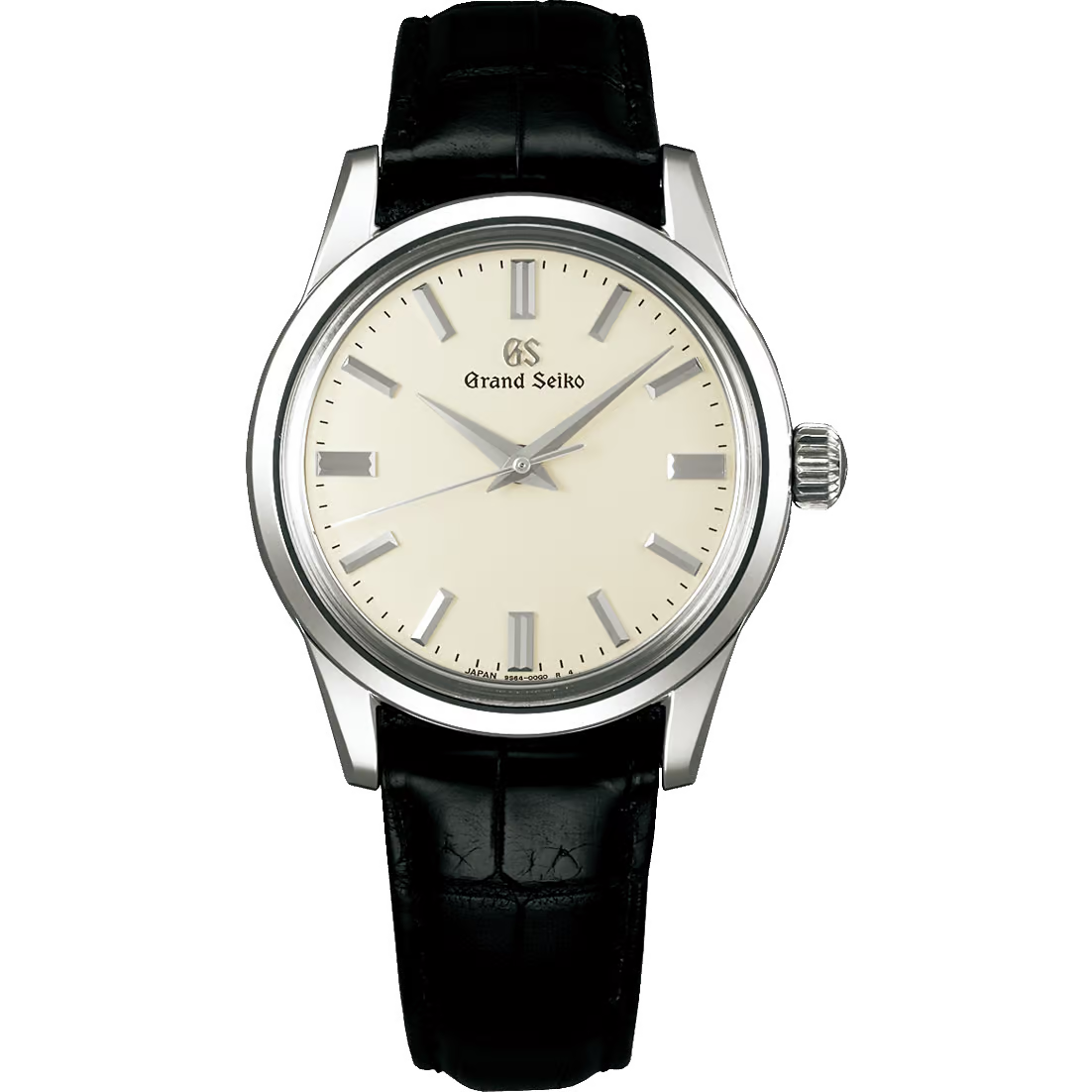
Technical Sheet: Launched in 2018 for the international market, the SBGW231 joins the “Elegance” collection. It houses the in-house 9S64 manual-winding caliber (24 jewels, 72-hour power reserve, 28,800 vph), housed in a steel case measuring 37.3 mm in diameter and 11.6 mm in thickness. Water-resistant to 30 m, protected by a “box shape” sapphire crystal (domed like vintage plexiglass), it comes on a black crocodile strap with a pin buckle. Its uncluttered dial (not even the “Diashock” or “Ja” mention from Japan, inscribed in very small print at the bottom) displays a simple “Grand Seiko” under the double index at 12 o’clock, and the discreet indication “JAPAN 9S64 …” at the bottom. The screw-down case back is sapphire, revealing the decorated movement (radial Geneva stripes, blued regulator hand). The design is an almost modernized carbon copy of a 1967 Grand Seiko (the 4420-9000 44GS) in a no-date version. In hand, one is struck by the sharpness of the case edges, the maximum readability of the cream dial, and the smoothness of the 9S64 winding. It is a piece that may not look like much to the novice, but embodies the quintessence of GS style for the initiated.
Price 2015 vs. 2025: This model did not exist in 2015. However, we can consider its spiritual equivalent from that time, the SBGW033 (a 2011 reissue of a 1964 GS in 38 mm), which sold for around €3,500 in 2015. In 2025, the SBGW231, now discontinued new (its list price was US$4,300 in 2018), can be found二手for around €3,000 (approximately $3,200) in very good complete condition. Estimated CAGR: +1 to 2%/year over 10 years (seemingly low progression, but remember the euro weakened during this period). Most importantly, the SBGW231 has depreciated very little since its release, a sign of sustained collector interest.
Potential Analysis: The SBGW231 is what’s called a “future classic” – almost a pleonasm, as its design is already a classic of the past. Its asset? It offers the charm and proportions of a vintage Grand Seiko (37 mm, clean dial) with today’s reliability and finishing. Produced for only a few years, it is not officially limited but relatively rare on the market. Its manual movement gives it a “purist’s watch” feel, highly prized currently, and its lack of a date enhances dial symmetry (some prefer it to the recent SBGW291 “Oruri” with a blue dial, considered aesthetically less authentic). Frankly, how can one resist this piece that could be the “unique GS” in a collection? We bet that within 5 years, it will be unobtainable under €5,000: its appreciation potential is moderate but certain, say +50% over the next decade. At this price, it’s almost a giveaway for a watch of this caliber (easy pun!).
2. Grand Seiko SBGR001 (Cal. 9S55) – The Mechanical Renaissance of 1998
Technical Sheet: The SBGR001, introduced in 1998, is the first mechanical Grand Seiko of the modern era. After a 20-year hiatus (GS had only produced quartz watches from 1975 to 1988, then nothing until 1998), it marks the resurrection of traditional know-how. Its 9S55 automatic caliber (first generation, 28,800 vph, 50-hour reserve, 25 jewels) was then brand new and ambitious, capable of -3/+5 sec/day adjusted accuracy – a chronometer level. As for the case, we find a 37 mm diameter steel case, ~13 mm thick, water-resistant to 100 m, with a flat sapphire crystal. The design is typical GS style: rather thick case middle, thin and polished bezel, large silver dial with polished baton indexes, double index at 12 o’clock, date window at 3 o’clock, and central seconds hand. Notably, the dial bears two logos: “Seiko” applied at 12 o’clock and “GS Grand Seiko” at 6 o’clock (an era when GS was still a Seiko sub-line). This gives it a particular charm for aficionados, as the double signature is synonymous with a specific period in GS history (until 2017).
Price 2015 vs. 2025: In 2015, a used SBGR001 could be found for around €1,800 to €2,000. Many examples were circulating in Japan, some showing signs of age (scratched crystal, dulled luminescence on the hands of early batches). In 2025, the price remains modest: expect around €2,500 for a complete example in good condition (often imported from Japan, VAT to be added). This implies a CAGR of ~+3%/year over 10 years, almost matching inflation. In other words, its real price hasn’t budged – making it a bargain when considering the price hikes of Swiss watches from that period.
Potential Analysis: At first glance, the SBGR001 is nothing extraordinary – that’s precisely its strength. It embodies the continuity between vintage and modern, being the very first to revive the Grammar of Design. Its case is not the thinnest or most refined in the lineup, but it lays the groundwork. For a long time, it remained in the shadows, with collectors preferring later evolutions (SBGR051 in 2010, SBGR253 in 2017). However, the SBGR001 benefits from an invaluable asset: it is “the first modern mechanical GS.” As such, it is beginning to attract the covetousness of fans interested in the brand’s history. Furthermore, its dual Seiko/GS logo dial, far from being a flaw, is becoming a charming vintage element (a future object of study, who knows?). Currently inexpensive, it offers an unbeatable quality-price ratio (reliable 9S movement, elegant design, GS finishing) compared to Swiss competitors. Its upside potential is real but likely slow: one can envision it doubling in value within 10 years if the vintage Grand Seiko hype continues. It’s also a piece of history you acquire with it. In short, a must-have piece for any GS aficionado who wants to understand where the renaissance began, and who might one day regret not buying itDirt cheap.
Discover the Grand Seiko SBGR001 on Catawiki (a chance to find this historic model at auction).
3. Grand Seiko SBGX059 (Cal. 9F62) – 37mm Heritage Quartz Elegance

Technical Sheet: The SBGX059 was released in 2003 (Japanese market exclusively). It is a Grand Seiko “Quartz Standard” par excellence. 37mm steel case, 100m water resistance, thickness around 10mm, high-quality integrated steel bracelet (solid links, deployant clasp). Its movement, the 9F62 caliber, is a concentrate of technology: 5-jewel thermo-compensated quartz, accurate to ±10 seconds… per year! Equipped with unique features (dual-impulse seconds hand for wide hands, and above all, a quick-access battery hatch without disassembling the entire movement – a very Seiko detail), it is hand-assembled and regulated by GS watchmakers, on par with a prestigious mechanical caliber. The SBGX059’s dial is a creamy white with a velvety finish, with only the thin, blued (non-luminous) central seconds hand animating the ensemble. Raised indexes and hands are Zaratsu polished, offering brilliant reflections with every wrist movement. The date window, metal-framed, displays a white disc. At the bottom of the dial are the “Quartz” mention and the GS logo. It is a piece that, placed on a table, could be mistaken for a mechanical GS due to its traditional finishing – only the ultra-precise step of the seconds hand betrays its electronic nature.
Price 2015 vs. 2025: In 2015, an SBGX059 could be found in Japan for around ¥120,000 (€900) used, as GS quartz was internationally overlooked. Those who bought one then got a good deal: in 2025, it trades for around €1,500 (approx. $1,600 / ¥225,000 / S$2,400) in near-mint condition, practically its original new price. Estimated CAGR: approx. +5%/year over 10 years (but starting from a very low level). This remains very reasonable and makes it one of the most accessible GS watches on the market.
Potential Analysis: The SBGX059 is somewhat the ideal “everyday GS.” Its contained format (37mm) and maintenance-free movement (replace the battery every 3 years, if that) make it the ultimate pleasure watch. For a long time, GS quartz watches suffered from a lack of recognition (purists swore only by mechanical). But that’s changing: the current generation of collectors is beginning to understand the incredible technical value of the 9F and its historical significance (Seiko put as much care into its 9F as its 9S). The SBGX059 is one of the most “pure GS” incarnations of this quartz aspect. It has nothing to attract flippers or quick speculators: it’s a three-hander with no limited edition, produced in modest quantities but over several years. Yet, I bet its price will eventually rise 얼굴, as Grand Seiko gains prestige. When a GS quartz is worth as much as a mechanical one, some will fall off their chairs… Better to acquire it while it remains at an almost derisory price considering its qualities. At €1,500, it’s a steal: case and bracelet worthy of €10,000 watches, astronomical precision, and timeless design. Its potential over 5-10 years? Probably a moderate increase (+50% perhaps), as the JDM market offers quite a few. But even without a value explosion, what a brilliant object to wear, especially when you know its pedigree!
Find the Grand Seiko SBGX059 on Catawiki (check out the offers for this elegant Heritage quartz).
4. Grand Seiko SBGR253 (Cal. 9S68) – Modern Automatic, Return to 37mm
Technical Sheet: The SBGR253 was released in 2017 as part of the Heritage collection. It is powered by the 9S68 caliber, an evolution of the 9S65 with a frequency lowered to 4 Hz for a power reserve extended to 72 hours. This automatic movement (manual winding possible) displays hours, minutes, seconds, and date, with an announced accuracy of -3/+5 sec/day (under ideal conditions). The case measures 37 mm in diameter, ~13 mm thick, and 44 mm lug-to-lug. It is quite stout, giving it presence despite its small size. Water-resistant to 100m and anti-magnetic to 4,800 A/m, it is versatile. The SBGR253’s dial is available in black or off-white (ours is black, deeply reflecting light). It proudly bears the “GS” logo alone at noon, the Grand Seiko lettering below, and the classic “AUTOMATIC” above 6 o’clock (plus the “Japan … 9S68” graduation at the bottom). The applied indexes are very similar to those of the SBGR001 or 051, as are the dauphine hands. The date window is at 3 o’clock, without a cyclops (phew). All protected by a flat, double-sided AR-coated sapphire crystal. The SBGR253 was produced from 2017 to around 2021 (then replaced by equivalent references with the non-hi-beat 9S65 caliber in the Heritage range). It represented the mechanical entry-level of the new “Seiko-less” Grand Seiko.
Price 2015 vs. 2025: Not existing in 2015, we can look at its older sibling, the SBGR051 (same characteristics, with dual logo), which retailed for ~€4,500 new and sold for €3,000 in 2015. The SBGR253 new cost around €4,200 in 2018, and today it can be found used for around €3,300 complete (often around US$3,500, or ¥500,000). Its 10-year CAGR is therefore almost nil: it is typically a GS whose value has remained flat, a collateral victim of the late craze for the brand (and the myriad of similar competing references).
Potential Analysis: The SBGR253 is probably the least “exciting” on this list in the eyes of a speculator, precisely because it is very classic and recent. Yet, it is one of my personal favorites (yes!). Why? Because it embodies the everyday ideal. You want an automatic GS, reasonable size, timeless look, and not a hint of bling? Here it is. It distills everything we love about GS: contained dimensions, exemplary readability, proven robustness (I know people who swim with their SBGR). Moreover, it has the sentimental value of being one of the first “true” Grand Seikos independent of the name. In the long run, this will matter to collectors. Its short-term upside potential is low (supply remains abundant in Asia, where it was a fairly well-sold entry-level model). However, in the long term, who knows? When GS has won as many fans as Omega or Rolex, people will delve back into the archives and rediscover these founding references. With a current price around €3,000, it is one of the best qualitative bargains in luxury watches. I can see it reaching €5,000 by 2030 (i.e., +4-5%/year) if Grand Seiko continues its ascent. Not enough to get rich, but enough to proudly wear a piece that will appreciate instead of depreciate. And besides, how can you not fall for its discreet charm? This is typically the GS we underestimate today and will adore tomorrow.
The Grand Seiko SBGR253 awaits you on Catawiki (check the sales to find this modern classic).
5. Grand Seiko SBGH001 / SBGH005 (Cal. 9S85) – Hi-Beat 36,000, Classics from 2010
Technical Sheet: The SBGH001 (sunburst silver dial) and SBGH005 (black dial) are the launch references for the 9S85 Hi-Beat caliber. This 5 Hz automatic movement (36,000 vph) offers a 55-hour power reserve thanks to an optimized barrel, and a theoretical accuracy of -1/+8 sec/day in real use (a Grand Seiko Special level). The steel case is larger than its predecessors: 40.2 mm in diameter, 13 mm thick, approximately 47 mm lug-to-lug. It remains comfortable, however, thanks to slightly downward-curved lugs. The crown is screw-down, ensuring 100m water resistance, and the watch features a sapphire case back exposing the gold GS rotor. The overall design is largely inspired by the 1968 61GS (the first GS hi-beat) with, for example, the date at 3 o’clock without a cyclops and the “Seiko” logo alone at 12 o’clock, “GS Automatic Hi-Beat 36000” above 6 o’clock. Yes, indeed: in 2010, GS was still stamped Seiko – it wasn’t until 2017 that the SBGH001/005 became the SBGH201/205 signed GS only. These watches have an incredible charm: the SBGH001’s silver dial is shot through with golden reflections in the sun, while the SBGH005 plays on abyssal depth. Both have highly detailed hands and indexes (the hour and minute hands are faceted and brushed on one side, polished on the other, creating typical light flashes). The seconds hand is thin and moves 10 steps per second, giving the impression of a smooth glide. On a steel bracelet, the whole thing has weight but exudes quality.
Price 2015 vs. 2025: In 2015, these hi-beat models traded used for around €4,000 (the new price was around €6,500 at the time). As Grand Seiko was still niche, there wasn’t a rush… In 2025, an SBGH001 or 005 (in the dual-logo Seiko version) can be found for around €3,000 – €2,800 for an example without a box, up to €3,500 for a full mint set. This is notably below the newer SBGH201 version (GS logo only), which hovers around €4,500. Thus, over 10 years, these references have barely budged (+1 to 2%/year maximum). They are among the GS models whose prices have remained dormant for a long time. Estimated CAGR: +2%/year, if that.
Potential Analysis: Here are perhaps the most undervalued Grand Seiko watches on the current market. Consider this: a high-frequency watch, a worthy rival to the Rolex Daytonas of its time in terms of technical prowess, hand-finished, produced in reasonable quantities (a few thousand examples nonetheless), celebrating an important anniversary… and yet trading for around €3,000. It’s almost absurd. I remember that when they were released, these SBGH0xx impressed the specialized press (and me first): GS proved it could reliably remake 36,000 vph movements, where the Swiss (Zenith aside) had given up. Alas, their somewhat austere design and their 40mm size, large for a GS, may have deterred some. No matter, they are rocks of quality. The question is: will their value ever take off? I am convinced it will. Firstly, because they are magnificent, and those who own them are starting to proclaim it on forums (the famous “glossy dial” of the 005 turns heads). Secondly, because hi-beat has become an emblem of GS (new hi-beat models start at over €8,000). When collectors delve into the 9S85 family tree, they will realize that these SBGH001/005 are its original stock. Finally, their relative rarity outside Japan (little distributed in the West at the time) will work in their favor. My firm opinion: this is an absolute sleeper. At €3,000 today, I’d buy two if I could. By 2030, I wouldn’t be surprised to see them flirting with €6k to €7k. Their potential is therefore high (investment rating 8/10, see table section). And in the meantime, what a joy to wear… that frenetic ticking of the hi-beat, faintly audible when held to the ear, is the music of the future already playing in the present.
6. Grand Seiko SBGA001 / SBGA003 (Cal. 9R65) – Classic “Gen 1” Spring Drive
Technical Sheet: The SBGA001 (ivory dial, steel dauphine hands) and SBGA003 (black dial, steel hands) marked Grand Seiko’s entry into the Spring Drive era in 2004. This revolutionary 9R65 movement combines a traditional mainspring with an electronic quartz regulator to deliver a seconds hand with a perfectly smooth glide (and an accuracy of ±15 s/month). With a quartz frequency of 32,768 Hz, it offers a 72-hour power reserve via a single barrel. On the dial, this translates to a seamlessly gliding seconds hand and a discreet power reserve indicator (graduated fan) between 7 and 8 o’clock. The steel case measures 40.5 mm in diameter and approximately 12.5 mm thick, with a thin, highly polished bezel, a domed sapphire crystal, and a screw-down crown ensuring 100m water resistance. Its design is a skillful blend of tradition (overall shape reminiscent of the 44GS) and modernity (sapphire case back displaying the caliber adorned with a signed rotor). The indexes are those of the Heritage range: sober but superbly polished. The overall finish gives an impression of robust elegance. Notably, the SBGA001 had a steel case and a slightly champagne “cream” dial, while the SBGA003 offered a deep black dial and a steel case. In 2010, these references would be replaced by the SBGA101/103, then the emblematic SBGA211 in titanium (Snowflake). But the SBGA001/003 retain the status of Spring Drive Grand Seiko “pioneers.”
Price 2015 vs. 2025: Around 2015, an SBGA001 or 003 traded for about €3,000 in good condition, as demand wasn’t high for this type of model (Spring Drive remained a curiosity for many). In 2025, paradoxically, you can still find them for around €2,700 to €3,000 (some deals from Japan even list them at €2,500). In contrast, their more recent equivalent (SBGA201/203 from 2017) is worth closer to €3,500. The 10-year CAGR is therefore almost nil, or even slightly negative (-1%/year). In other words, their value hasn’t followed the Snowflake’s trajectory, for example.
Potential Analysis: One might call these SBGA001/003 the “forgotten Spring Drives.” They have everything to please: the poetry of a silent seconds hand gliding like time itself, a very balanced design, a technically astounding movement. And yet, they lack the media fanfare of the Snowflake (SBGA211) or the touch of eccentricity of the latest Spring Drives (textured dials, sporty hands…). Result: their prices stagnate, much to the delight of the savvy buyer. Because I tell you plainly: these watches are extraordinary to wear. The Spring Drive provides an indescribable zen sensation; you spend your time watching that seconds hand glide – it’s hypnotic (do I need to convince you further?). Investment-wise, I don’t see these references skyrocketing হঠাৎ, but they will likely start to climb gently, in the wake of GS’s overall success. In the long run, when Spring Drive has earned its stripes among the great watchmaking patents, the first of their kind will appreciate in value. Let’s say a moderate potential of +50% within 10 years, which is still an excellent bonus. But even without that, you’re buying a unique experience of time here. PS: If you find one, just check that it has been serviced recently (Spring Drive needs an overhaul every ~10 years at a GS center), just to be safe. Other than that, go for it – it’s an underrated technological work of art.
7. Grand Seiko SBGX061 (Cal. 9F62) – The Black Solar Elegance (Quartz)
Technical Sheet: The SBGX061 is the twin sister of the SBGX059, with a lacquered black dial instead of a light one. Also released in the mid-2000s (JDM model), it features the 37mm steel case, the ultra-precise 9F62 movement, and the clean design عزيز to GS. Its shiny black dial offers a striking contrast with the polished indexes and hands, providing exemplary readability. At night, no lume – GS quartz focuses on pure elegance. The SBGX061 also bears the dual Seiko/GS logo on early models, then just GS towards the end of production (after 2017). On a steel bracelet, it is versatile, from a suit to a weekend polo shirt. In short, a classic Grand Seiko “Heritage Quartz,” dark dial version for those who prefer it to the light SBGX059.
Price 2015 vs. 2025: Similar to the 059, it was around €900 in Japan in 2015. In 2025, expect around €1,500 for a nice example (some collectors are willing to pay a small premium for the rarer black dial). Its CAGR is therefore in the same order as the 059, ~+5%/year. Nothing spectacular, but a slow and steady progression.
Potential Analysis: The SBGX061 benefits from everything said for the 059: reliability, quality, discretion. Its black dial gives it a slightly more sporty/sober presence depending on the light. It is typically the single watch one can wear for 20 years without tiring of it or needing to pamper it excessively. From an investment perspective, it shares the fate of the other: still ignored outside connoisseur circles, but possessing all the qualities to seduce them. Its relative rarity (fewer are seen than light dials) may slightly favor a more marked increase. But let’s be realistic: it’s quartz, and a gentle rise. Perhaps if a famous influencer starts praising GS quartz, the situation will change? Who knows. In any case, I recommend it more for the pleasure of owning it than for pure capital gain. And as a bonus, you’ll have the satisfaction of wearing what I call a “Trojan horse”: a watch that from a distance looks like any three-hander, but houses an exceptional caliber. Seeing watch enthusiasts’ faces when you tell them your simple “Seiko” (as many don’t even notice the GS on the dial) has an annual accuracy of 10 seconds and a hand-finished movement… that’s priceless (or almost).
8. Grand Seiko SBGW253 (Cal. 9S64) – Limited Edition “First” 1960 in Steel
Technical Sheet: The SBGW253 is a limited edition released in 2017 (1,960 pieces) to commemorate the very first Grand Seiko model from 1960. It is a faithful reinterpretation of the original reference (GS 3180) in a 38mm steel case, powered by the 9S64 manual caliber. Its design is pure vintage: no seconds hand, a domed opaline dial adorned with the vintage Grand Seiko logo (cursive script and golden star at 6 o’clock, a sign of Chronometer precision like its ancestor). The case features thin lugs, a gracefully curved profile (different from the angular 44GS style – this is “Grammar of Design” avant la lettre, softer). Delivered on a brown alligator strap, this SBGW253 was sold new for ~€5,300 and was snapped up immediately. Today, it’s almost a grail for fans, combining an irresistible mid-century aesthetic with a reliable modern movement.
Price 2015 vs. 2025: No 2015 comparison (it didn’t exist). In 2025, its value on the grey market reaches €6,000 to €7,000 (well above our €5k benchmark). Technically, it shouldn’t be listed here, but I mention it for the record because as recently as 2018, it could be had for €4,800 used in Japan. Its 5-year CAGR is spectacular, > +10%/year – proof that beautiful GS models eventually take off. 🡆 Outside official ranking.
Potential Analysis: (Outside ranking).
9. Grand Seiko SBGM221 (Cal. 9S66) – Classic Cream GMT
Technical Sheet: Introduced in 2016-2017, the SBGM221 immediately captivated travel watch enthusiasts. It adopts a 39.5mm steel Elegance case, quite thin (13.7mm) and rounded, very different from pure “Grammar of Design” cases. Yet, it deserves its place here for its finishes and decidedly GS style: magnificent lacquered cream dial, polished indexes, dauphine hands + thin blued GMT hand, and a tone-on-tone date window. Its 9S66 caliber offers a “flyer” GMT complication (jumping hour hand) – a rarity at GS. With its “box” crystal and sapphire case back, it exudes discreet luxury. Sometimes nicknamed “Grand Seiko Paris” for its chic appeal, it is a piece loved by connoisseurs.
Price 2015 vs. 2025: New ~€5,500, it can be found in 2025 for around €4,200. It therefore depreciated gently then regained some value (after its withdrawal from the catalog). Over 10 years, perhaps -1%/year. Nothing 가격, as it was sold new until recently.
Potential Analysis: The SBGM221 is not a strict “Tanaka” product – its rounded case, its internal date magnifier, all make it almost “European” in style. But what a watch! Those who own one rave about its versatility. It is becoming well-known (Hodinkee praised it), which could drive its price upwards. Its potential seems decent, nothing more, as many GS GMTs have arrived since (9F quartz GMTs, Spring Drive GMTs, etc.). It nevertheless remains a future classic. And as often happens, it’s when it becomes unobtainable that we’ll mourn its past price…
10. Grand Seiko 4420-9000 “44GS” (Cal. 4420) – The Original from 1967
Technical Sheet: How not to close this top 10 with the watch that started the Grammar of Design: the 1967 Grand Seiko 44GS? Reference 4420-9000, it housed a 4420B manual-winding caliber, 18,000 vph, Chronometer certified. Its 37.9mm x 11mm steel case laid down the Tanaka codes: long flat facets on the flanks, sharp corners, mirror-polished case middle surface, etc. Sunburst silver dial, ultra-angular steel indexes, double index at 12 o’clock, dauphine hands, no date for purity (date versions of the 44GS have ref. 4421). Flat “GS” signed crown, screw-down case back adorned with a gold lion medallion. Produced in ~36,000 examples between ’67 and ’69, it is a major historical piece.

Price 2015 vs. 2025: In 2015, one could be found in Japan for €1,500 (sometimes with a retouched dial or repolished case). In 2025, for a fine original example, expect closer to €3,000 (and more if complete with rare box/papers). CAGR ~+6%/year over 10 years, but progression accelerated after 2020. Very fine examples fetch high prices at specialized sales (€4-5k).
Potential Analysis: The original 44GS is the ultimate “Grammar of Design” to grab while it’s affordable. Its historical importance is enormous (it is literally the manifesto watch of the GS style). True, it’s vintage: 36,000 examples isn’t ultra-rare, but how many are in good condition today? Many have suffered (pitted dials, poorly polished cases losing their edges). The most discerning Japanese collectors snap up those in mint condition. In my opinion, by 2030, the value of 1960s 44GS models will follow that of King Seiko Chronometers or vintage Zenith chronographs: a handsome surge as supply dwindles. It must also be mentioned that Seiko/GS has released numerous reissues (in gold, steel, etc.), which have a magnifying effect on the original – it’s when you see the reissue at €8,000 that you think, “and the original is worth how much? only €3,000?”. This phenomenon of communicating vessels will, I believe, push the 4420-9000 to greater heights. Its potential is therefore very high (but one must accept the constraints of vintage, so it’s not for everyone). Personally, I consider it a grail to obtain if one claims to be a GS fan – and I wouldn’t be surprised if it tripled in value in 15 years. After all, a certain 1967 Submariner was worth €1,500 in 2005… Look at its price now (we’re not comparing GS and Rolex, but still!). The 44GS is to Grand Seiko what the Speedmaster 321 is to Omega: a founding pillar, largely undervalued for too long.
Summary Table: 10 GS “Grammar of Design” Models, Estimated 2025 Prices and Potential
| Model (Reference) | Estimated Price 2025 (EUR) | USD | JPY | SGD | Investment Potential |
|---|---|---|---|---|---|
| SBGW231 (2018) | €3,000 | $3,250 | ¥450,000 | S$4,500 | ★★★☆☆ (7/10) |
| SBGR001 (1998) | €2,500 | $2,700 | ¥375,000 | S$3,800 | ★★★★☆ (8/10) |
| SBGX059 (2003) | €1,500 | $1,600 | ¥225,000 | S$2,400 | ★★★☆☆ (6/10) |
| SBGX061 (2003) | €1,500 | $1,600 | ¥225,000 | S$2,400 | ★★★☆☆ (6/10) |
| SBGR253 (2017) | €3,300 | $3,500 | ¥500,000 | S$4,950 | ★★★☆☆ (7/10) |
| SBGH001 / 005 (2010) | €3,000 | $3,250 | ¥450,000 | S$4,500 | ★★★★☆ (8/10) |
| SBGA001 / 003 (2004) | €2,700 | $2,900 | ¥405,000 | S$4,050 | ★★★☆☆ (6/10) |
| SBGM221 (2017) | €4,200 | $4,550 | ¥630,000 | S$6,300 | ★★★☆☆ (6/10) |
| 44GS vintage 4420 (1967) | €3,000 | $3,250 | ¥450,000 | S$4,500 | ★★★★★ (9/10) |
| SBGW253 (2017, LE) | €6,500 | $7,050 | ¥975,000 | S$10,000 | Not applicable |
Comparison: Performance of “Grammar of Design” Models vs. Other GS Collections
Given this overview, one might wonder how the values of “classic” Grand Seiko models evolve compared to other segments of the brand (recent Evolution 9 collections, Sport line, atypical limited editions, etc.). Generally, models inheriting the Grammar of Design (typically Heritage / Elegance models with sober dials and Zaratsu cases in 44GS or 62GS style) have shown a relatively stable but positive value evolution over the last decade. They haven’t experienced the sudden explosion of some limited editions (e.g., a “Kira-Zuri” SBGH269 from the 2019 series, with a textured red dial, doubled in price in 2 years), nor have they plummeted. They form a safe foundation, much like Rolex Datejusts in the Rolex universe: no wild speculation, but steady appreciation linked to the growing recognition of GS quality.
Conversely, more recent collections like the Evolution 9 (appearing in 2021) have seen fluctuating values. Concrete example: the highly publicized SLGH005 “White Birch”, with its white birch dial and Evolution 9 design (40mm case with wide lugs, new, more massive hands), sold above retail for a year, then briefly rose above with the hype, before finally stabilizing around the boutique price. In short, no crazy capital gains for now (expect ~€9,000 in 2025, vs. €9,300 new) for this award-winning model. The same goes for various Spring Drive Evolution 9 models (revamped Snowflake, etc.): initial enthusiasm drove up prices on the grey market, but production followed and prices calmed down. We are far from Patek Nautilus scenarios where values triple… And that’s a good thing for the sane enthusiast.
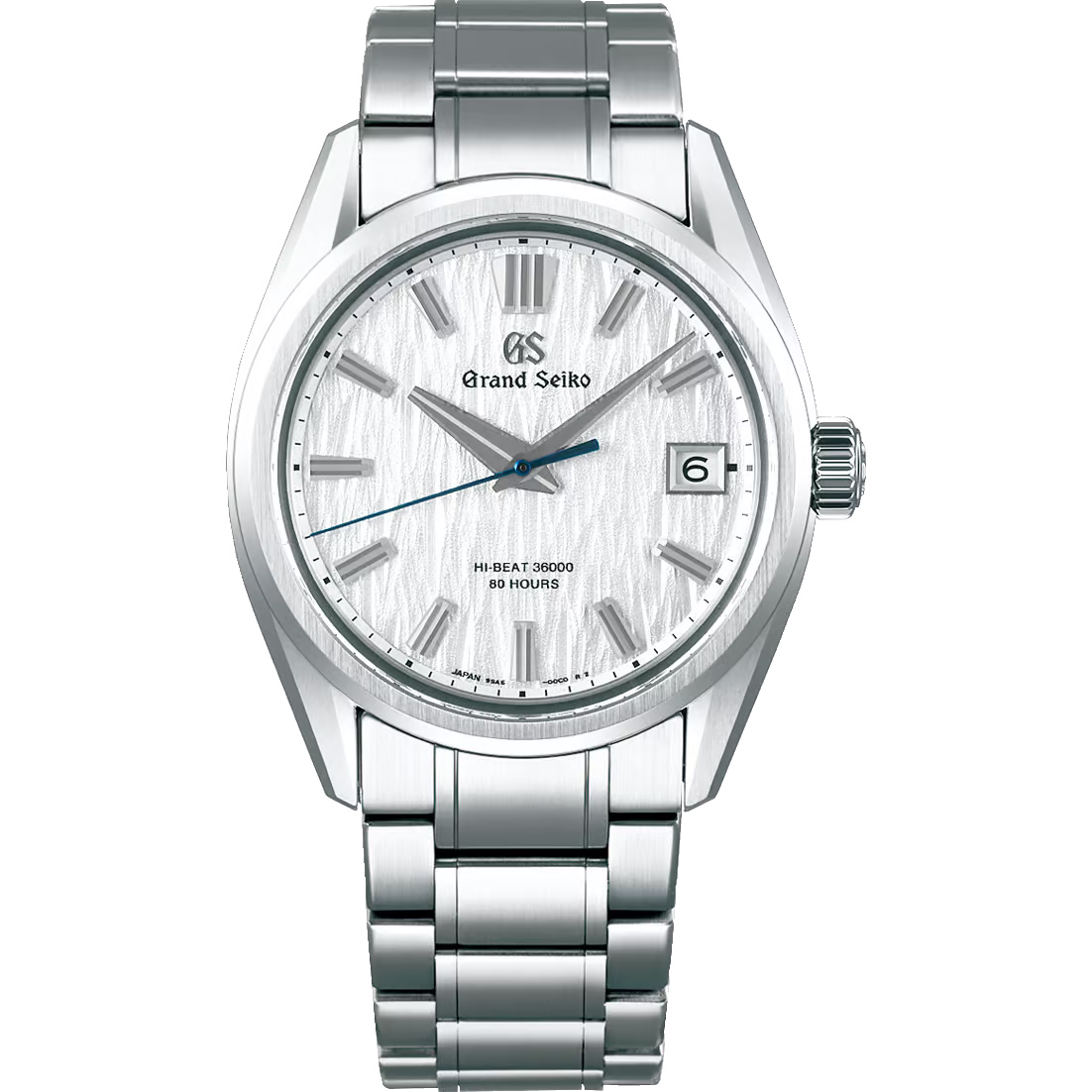
As for Sport models (various GMTs, Spring Drive chronographs, 200m divers), their valuation is very disparate. “Marinemaster” divers (SBGX115/117 in 37.5mm, or the large SBGA229) show notable depreciation on the used market, a sign that they are not (yet) favored by discerning collectors. Conversely, some special editions like the SBGE249 (Spring Drive GMT “Skyflake”) or the SLGA001 (50th anniv. titanium diver) hold their value well or even sell for more than new, driven by their rarity and strong aesthetic appeal. But overall, it is the Heritage/Elegance segment – i.e., watches aligned with the Grammar of Design codes – that seems to offer the best stability/progression pairing. There’s a simple reason: these watches age well, both physically and mentally. An SBGR251 or SBGW231 in 2035 will still be as elegant and relevant as in 2015, while some very distinctive GS models (very colorful dial, massive sporty design) might go “out of fashion.” We always come back to the maxim in collecting: classics are a sure value.
Ultimately, Grand Seiko Grammar of Design models have had a calm but positive valuation performance, and above all, they form the heart of the brand – which tends to make them desirable over time. Other collections sometimes offer valuation peaks, but also more volatility. For example, a collector who bought an SBGH001 in 2015 will still have it today with perhaps a +0% gain, but years of undiminished pleasure. Someone who bought a highly speculative limited edition might have made a quick +50%… or ended up with an unsellable watch because too much hype kills the hype. It’s hard not to see a parallel with the world of spirits or art: there are the timeless grand crus one savors without worrying about the price, and fads that come and go. Grand Seiko, by its positioning, fortunately attracts more enthusiasts than opportunistic investors – and that’s for the best.
Conclusion: Buying and Maintaining Your Grand Seiko “Grammar of Design” (Checklist)
In conclusion, if reading this article has made you want to take the plunge and acquire one of these beautiful Tanaka-style Grand Seikos, here is a small buying and maintenance checklist, the fruit of my experiences and (a few) mistakes:
- Authenticity and Completeness: check the serial number engraved on the back, the possible presence of original papers (rare on vintage, more common on modern). The GS logo on the dial must be applied (not painted except on very old models) and correspond to the era. On vintage models, beware of overly new repainted dials.
- Polishing: prefer an unpolished case or one polished according to the rules. Zaratsu is a difficult art: poor repolishing will round the edges and ruin the mirror effect. Better a few signs of use than a botched “restoration.” If in doubt, a GS service center can redo the factory polish (but the cost is high, around €500).
- Model Consistency: ensure the bracelet is original (for steel models), the crown is GS signed (after 1966) and corresponding, the seconds hand has the correct shape… Frankenwatches are rare with GS, but on vintage, KS/GS case/movement marriages have been seen from unscrupulous sellers. A careful eye and consultation of period catalogs (available online) will dispel doubts.
- Movement Maintenance: a GS caliber, whether 9S mechanical, 9F quartz, or Spring Drive, deserves a service every 5 to 10 years depending on use. Grand Seiko guarantees maintenance of its calibers for at least 25 years after end of production (often longer). Do not hesitate to send the watch to the Official Service Center: it’s not cheap, but the work is impeccable, and they will repolish the case and bracelet if requested. Avoid third-party watchmakers not trained by GS for Spring Drive and 9F (proprietary technology).
- Wear and Storage: a “Grammar” GS is worn like a dress watch; even sport models have an elegance one will want to preserve. Avoid violent shocks (especially on sharp polished edges). For vintage models, consider changing the gaskets if you want to wear it daily (original water resistance no longer holds). Store the watch away from humidity and magnetism (9Fs are sensitive to magnets, despite their protection; same for older models).
- Customs and Import: if buying from Japan, anticipate the ~20% VAT+fees upon arrival. Sometimes, even with that, the deal is still good. But do your calculations calmly (I’ve seen eBay buyers cry sorpresa at DHL fees… almost amateurs!). In Europe, you will pay VAT in your country, but no double taxation if Japanese VAT has already been paid (via the Refund procedure for professional purchases).
By respecting these few points, you will start off on the right foot in the Grand Seiko universe. These are watches made to last for generations, so treat them with the love and respect they deserve. Far from the speculative follies of other brands, they will provide you with pure, lasting horological satisfaction – and who knows, one day their value might reward your foresight in acquiring these marvels before they take off. In the meantime, enjoy them, collect them, admire the play of light on the hands with every ray of sunshine… That, too, is the “Grammar of Design”: principles that make the watch and light converse, for the pleasure of the wearer. Happy hunting for Tanaka-style Grand Seikos – and don’t forget, as our Japanese friends say: 「腹八分目」 (harahachibunme, literally “stomach 8/10 full” – in watchmaking, this means always keeping a little space for the next GS in your collection…).
